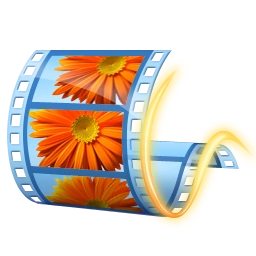
Image via Logopedia.
My Book Trailer Project is well on its way and I am pretty excited with my progress thus far. As I discussed in my last post, I was debating on what program to use for creating book trailers – Photo Story 3 or Windows Movie Maker. After playing around with the programs, I finally decided on Windows Movie Maker. Photo Story 3 definitely had some benefits (i.e. it has music you can use, it’s very step-by-step, very simple, etc.), but ultimately I found Windows Movie Maker more user-friendly (for me) and with more flexibility and options. I liked that Windows Movie Maker had everything all on one screen in which you just used the tool bar at the top of the page to navigate and make adjustments. Photo Story 3 required you clicking next and back if you wanted to switch things up. Movie Maker also had the option of adding in title slides and blank slides, which Photo Story 3 did not (you’d have to upload a black picture to make a black slide). In the end, I think I am happy with my choice and I think my staff (and students) will feel comfortable using it.
Even though Windows Movie Maker is a relatively new program for me to use, because I have used iMovie in the past and am familiar with a variety of Microsoft programs (i.e. Word, Excel, Power Point, etc.), it was fairly easy for me to navigate and figure out. I spent quite a bit of time playing with different features (AutoMovies, animations, visual effects, captions, narration, music, timing, etc.). The trickiest aspect, to me, with making book trailers is simply timing the slides right (to go with narration, music, emphasis, etc.). It was easier adjusting the duration of each slide after I had done the narration and music. Having spent time playing with it, I would definitely feel comfortable using the program with students and in leading a workshop with staff.

Image by Michael Becks via Wikimedia Commons.
Now that I had figured out what program I was going to use for the book trailers themselves, I needed to figure out how I was going to present the workshop. Initially I thought about using Power Point, because I am comfortable with the program. However, I wanted to challenge myself, so I thought about using Prezi or Emaze. I used Prezi for the first time during this course for one of my Reading Review Blog posts. It was relatively easy to use, but one thing that frustrated me was that it limited videos that I could upload (it seemed to require me to only use youTube videos) and hyperlinks were a bit of a headache to put in (you had to type it out and press enter, thus limiting you from adding it to a different word). Emaze, on the other hand, seemed a bit more flexible (you could easily add any media and can hyperlink to whatever you’d like). I also preferred the templates that Emaze provided over the Prezi ones. I actually tried out Emaze before Prezi (I used it for one of my LLED 462 curations) and when I thought back to which one was more user-friendly and fun to use, it was definitely (in my mind) Emaze. Thus, I decided to make my presentation on Emaze. This way, too, I can publish it publicly so that others can use/view my presentation. Plus, I can literally use any computer for the workshop, as long as it is connected to the Internet.

Image by Gnome icon artists via Wikimedia Commons.
I know that this blog is also supposed to depict any struggles we have had with the technology thus far, but, in all honesty, I really haven’t struggled much. I’ve been using a variety of programs since I was in high school and have grown to be quite comfortable with technology (I was even the [.1 fte.] Computer Resource Teacher one year at my school), so any hiccups that came up, I simply used a Google search to troubleshoot. Thus, creating my presentation on Emaze has been quite easy. Like I mentioned above, it’s very user-friendly, has clear tools and directions, and is easy to navigate. In addition, because I have made a TON of Power Point presentations, it was an easy switch to Emaze (they share many similar features).

Image via Ramond.cc.
At this point, I am mostly done the slideshow aspect of my project, except I still need to embed my screen capture videos (which I have yet to do). I know previously I was unsure if I wanted to create a standalone video tutorial, but I’ve decided to instead embed screen capture videos directly into my workshop slideshow. When I am actually doing the slideshow, I will likely be modeling live (as opposed to using the video), but then I’ll be sure to provide my staff with my Emaze link so that they can go back and review the videos if they decide to tinker on their own and forget certain parts. In this way, whoever views my slideshow can also follow along to the video tutorials. At this point, I plan on doing three screen capture videos. One is simply modeling how to create a folder on your desktop, one is how to find and save images, and the last one is how to make the actual book trailer. I have started playing around with different screen capture recording programs. Originally, I thought I was going to use CamStudio. It’s a free download and is fairly easy to navigate. I liked that it gave the option of recording a specific area, a window, or the full screen. However, while playing around with it, I discovered that anytime I tried recording a longer video, I was having trouble saving (not fun!). After doing a Google search, I saw that it was an issue many people had dealt with. There is some potential to fix the problem by installing additional codecs, but I decided to take the opportunity to explore alternative programs instead. During my exploration, I came across IceCream Screen Recorder. The free version allows you to record for 10 minutes at a time, which should be sufficient for my recordings. It also had a friendly user-interface and seems to be easy to use (so far). I have played around with it a bit and it definitely has promise. I also plan on using Windows Movie Maker to edit any of my videos. In the meantime, I am organizing what I will include in the videos (i.e. what steps, what I’ll say, etc.).

Image via Softonic.
Finally, I’ve also been working on my Book Trailer handout and Book Trailer worksheets. For these, I am simply using Microsoft Word. Again, it is a program I am extremely familiar with and can navigate easily. The handout itself is a beginner’s guide to how to make book trailers using Windows Movie Maker. As such, I have been taking screen shots and using Paint.net to edit them to point out different features and steps. Again, I have used Paint.net to do this before, so I have had no problems doing this and inserting the images into the book trailer handout. The worksheet is quite basic and was created solely with Microsoft Word (text, drawing, and table tools). You can view my Book Trailer handout here and my Book Trailer worksheet here.

Image via Clipart Panda.
Overall, I am quite pleased with how my project is going so far. I’m getting very excited to see the end result. The only aspect I am a bit nervous about is the screen capture videos (in particular the editing of them). I have never done them before, so I am not as confident in my abilities as I am with other programs. I will be using my headset with microphone for the recordings. I know if I have issues that I will use a Google search to troubleshoot. If I am still stuck, my husband is a computer programmer, so I am confident that between the two of us we can troubleshoot anything that comes up. I am looking forward to the challenge!
References
Becks, Michael. (2014). [emaze logo]. Retrieved from https://commons.wikimedia.org/wiki/File:Emaze_logo_2014-02-09_19-45.jpg
CamStudios. (n.d.). [Screen Capture of program]. Retrieved from https://www.raymond.cc/blog/free-online-screen-recording-with-screencast-o-matic/
Clipart Panda. (2014). [Image of Smiley Face with Thumb up]. Retrieved from http://www.clipartpanda.com/clipart_images/thumbs-up-smiley-clip-art-33272228
Gnome Icon Artists. (2008). [Image of computer]. Retrieved from https://commons.wikimedia.org/wiki/File:Gnome-computer.svg
Icecream Screen Recorder. (n.d.). [Image of Icecream Screen Recorder]. Retrieved from http://icecream-screen-recorder.en.softonic.com/
Microsoft Windows. [Windows Live Movie Maker icon]. Retrieved from http://logos.wikia.com/wiki/Movie_Maker

Great overview of your technology you have implemented so far. You are demonstrating a lot of good independent learning skills, accessing prior knowledge, searching online when you have problems or challenges and seeking out new challenges rather than going with the old standby. A great post that can help others who are stuck with suggestions on accessible and easy tools to use to share your new knowledge and skills. Try to keep your screen capture videos shorter if possible so people can watch them in short chunks. Great stuff!
LikeLike
I wish I was as comfortable with all of the new technology as you are. I feel like I am pretty good at troubleshooting and figuring out the basics of most tools, but it definitely feels like it takes me a long time to format, which is something I would prefer not to spend my time on. You may have mentioned this in another post, but I’m wondering if you are going to have your students share their book trailers with each other or with a broader audience. One thing I have done in the past is had the students create their assignments and turn them into QR code labels that they could stick inside the front cover of the novel. That way other students who read the book (even a couple of years later) have the opportunity to view the book trailer before reading the book.
LikeLike